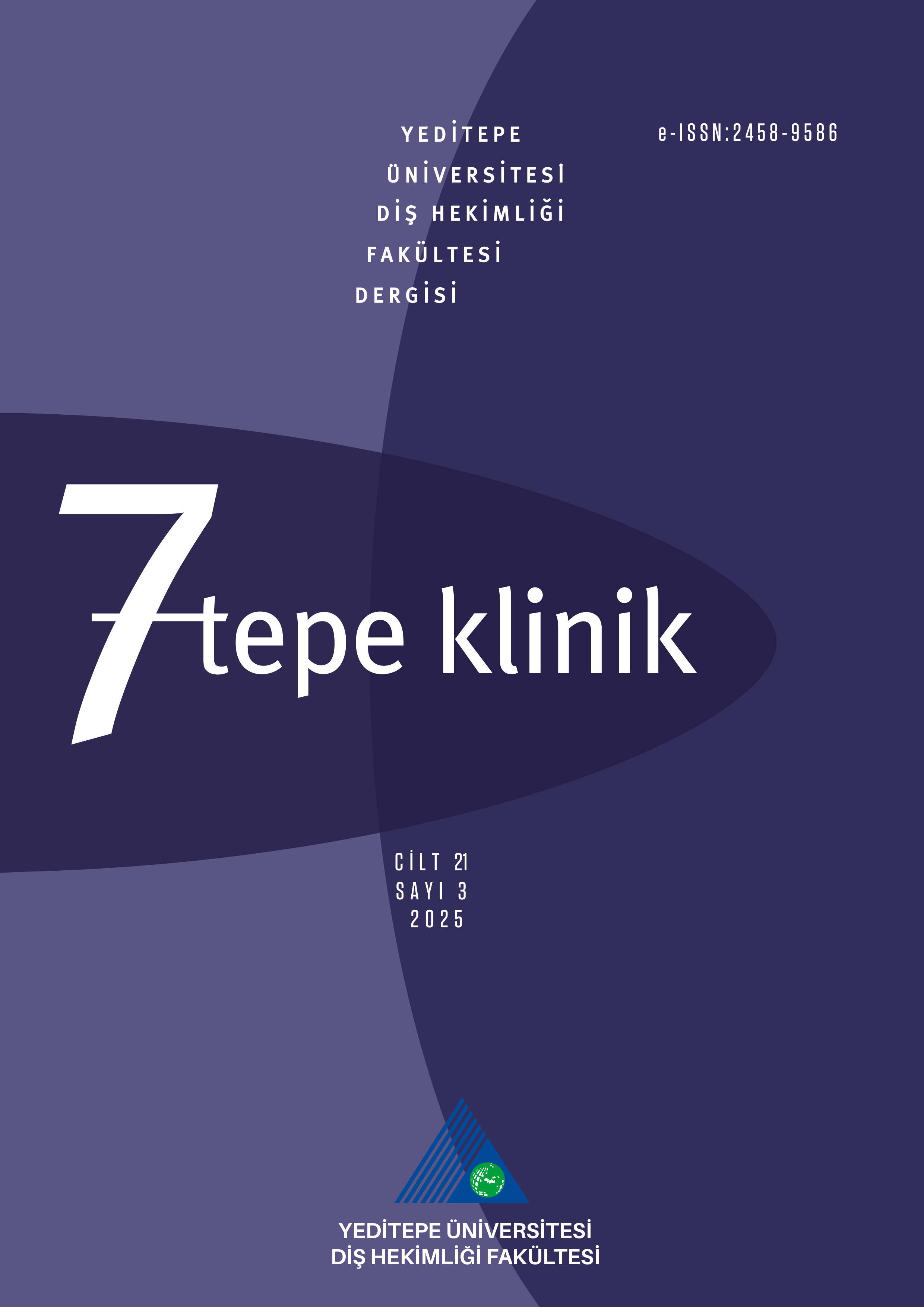Gıdaları taklit eden solüsyonların bulk-fill kompozitlerin renklenmesine etkisi
Özge Gizem Cabadağ1, Nihan Gönülol2, Lena Almasifar2, Tuğba Misilli31Özel Klinik, İstanbul2Ondokuz Mayıs Üniversitesi, Diş Hekimliği Fakültesi, Restoratif Diş Tedavisi A.D., Samsun
3Çanakkale Onsekiz Mart Üniversitesi, Diş Hekimliği Fakültesi Restoratif Diş Tedavisi A.D., Çanakkale
GİRİŞ ve AMAÇ: Bu çalışmanın amacı gıdaları taklit eden solüsyonlarda bekletilen yüksek viskoziteli bulk-fill kompozitlerin ve bir adet geleneksel kompozit rezinin renkledirici bir solüsyona maruz bırakılması sonrası renk değişimini değerlendirmektir.
YÖNTEM ve GEREÇLER: 4 farklı yüksek viskoziteli bulk-fill kompozit (Tetric EvoCeram Bulk Fill, SonicFill, Filtek Bulk Fill Posterior, Beautifil Bulk Restorative) ve bir adet geleneksel mikrohibrit tipte kompozit rezin (Filtek Z250) kullanılarak, 8 mm çapında ve 4 mm kalınlığında disk şeklinde toplam 180 adet örnek hazırlandı. Hazırlanan örnekler gıdaları taklit eden solüsyonlarda (etanol, heptan, sitrik asit, yapay tükürük) bekletilmek üzere rastgele 4 alt gruba ayrıldı (n=9) ve bu solüsyonlarda 7 gün süreyle 37±1ºCde etüvde bekletildi. Ardından örneklerin tümü çözünebilir kahve solüsyonunda 6 gün süreyle tutuldu. Tüm örneklerden, gıdaları taklit eden solüsyonlarda bekletilmesi sonrası ve kahve solüsyonunda bekletilmesi sonrası Vita Easy-Shade (VITA Zahnfabrik) dijital spektrofotometre cihazı yardımıyla renk değerleri elde edildi. Renk değişim değerleri (ΔE00), CIEDE2000 renk sistemine göre kaydedilerek, istatistiksel analizi için çift yönlü varyans analizi, ikili karşılaştırmalar için Bonferroni testi kullanıldı (α=.05).
BULGULAR: Test edilen kompozit grupları arasında en yüksek ΔE00 değerleri Beautifil Bulk Restorative grubunda tespit edilirken (p˂0.001), en fazla renk değişimi kahve solüsyonu öncesi sitrik asite maruz bırakıldığında gözlenmiştir (p=0.027).
TARTIŞMA ve SONUÇ: Gıdaları taklit eden solüsyonların ve materyallerin farklı yapısal özellikleri kompozit rezinlerin renk stabilitesinde etkilidir.
Effect of food simulating liquids on color stability of bulk-fill composites
Özge Gizem Cabadağ1, Nihan Gönülol2, Lena Almasifar2, Tuğba Misilli31Private Clinic, İstanbul, Turkey2Department of Restorative Dentistry, Faculty of Dentistry, Ondokuz Mayıs University, Samsun, Turkey
3Department of Restorative Dentistry, Faculty of Dentistry, Çanakkale Onsekiz Mart University, Çanakkale, Turkey
INTRODUCTION: To evaluate the color stability of high-viscosity bulk-fill composites and a conventional composite stored in food-simulating liquids after subjected to staining solution.
METHODS: A total of 180 disc-shaped samples (8 mm diameter and 4 mm height) were prepared using 4 different high viscosity bulk-fill composites (Tetric EvoCeram Bulk Fill, SonicFill, Filtek Bulk Fill Posterior, Beautifil Bulk Restorative) and one conventional microhybrid type composite resin (Filtek Z250). The samples were randomly divided into 4 subgroups (n=9) to be stored in food-simulating liquids (ethanol, heptane, citric acid, and artificial saliva) in an oven at 37±1ºC for 7 days. Then, all samples were immersed in a soluble coffee solution for 6 days. The color measurements of all samples were performed after storage in food-simulating liquids and after storage in coffee solution with a digital spectrophotometer (Vita Easy-Shade, VITA Zahnfabrik). Differences in color measurements (ΔE00) were calculated according to CIEDE2000 formula. Data were statistically analyzed with two-way ANOVA and Bonferroni tests (α=.05).
RESULTS: Among the tested resin composite groups, the highest ΔE00 values were detected in Beautifil Bulk Restorative (p˂0.001). Also, the highest color change in this composite group was observed when subjected to citric acid solution before the coffee solution (p = 0.027).
DISCUSSION AND CONCLUSION: The different structural properties of food simulating liquids and materials affects the color stability of resin-based composites.
Makale Dili: Türkçe



